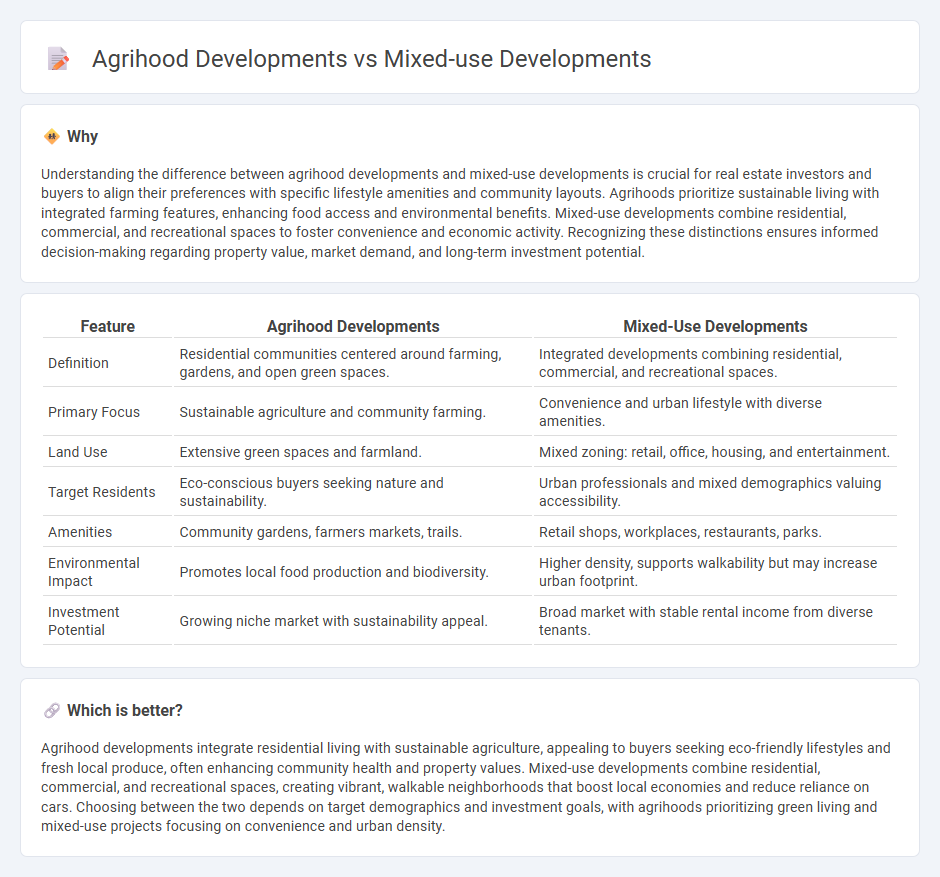
Agrihood developments integrate agricultural spaces with residential living, promoting sustainable food production and community engagement within neighborhoods, while mixed-use developments combine residential, commercial, and recreational facilities to create vibrant, multifunctional urban environments. These approaches address different lifestyle preferences and urban planning goals, with agrihoods emphasizing green space and local food systems and mixed-use developments focusing on convenience and economic activity. Explore the unique benefits and challenges of each development model to determine which suits your real estate vision.
Why it is important
Understanding the difference between agrihood developments and mixed-use developments is crucial for real estate investors and buyers to align their preferences with specific lifestyle amenities and community layouts. Agrihoods prioritize sustainable living with integrated farming features, enhancing food access and environmental benefits. Mixed-use developments combine residential, commercial, and recreational spaces to foster convenience and economic activity. Recognizing these distinctions ensures informed decision-making regarding property value, market demand, and long-term investment potential.
Comparison Table
| Feature | Agrihood Developments | Mixed-Use Developments |
|---|---|---|
| Definition | Residential communities centered around farming, gardens, and open green spaces. | Integrated developments combining residential, commercial, and recreational spaces. |
| Primary Focus | Sustainable agriculture and community farming. | Convenience and urban lifestyle with diverse amenities. |
| Land Use | Extensive green spaces and farmland. | Mixed zoning: retail, office, housing, and entertainment. |
| Target Residents | Eco-conscious buyers seeking nature and sustainability. | Urban professionals and mixed demographics valuing accessibility. |
| Amenities | Community gardens, farmers markets, trails. | Retail shops, workplaces, restaurants, parks. |
| Environmental Impact | Promotes local food production and biodiversity. | Higher density, supports walkability but may increase urban footprint. |
| Investment Potential | Growing niche market with sustainability appeal. | Broad market with stable rental income from diverse tenants. |
Which is better?
Agrihood developments integrate residential living with sustainable agriculture, appealing to buyers seeking eco-friendly lifestyles and fresh local produce, often enhancing community health and property values. Mixed-use developments combine residential, commercial, and recreational spaces, creating vibrant, walkable neighborhoods that boost local economies and reduce reliance on cars. Choosing between the two depends on target demographics and investment goals, with agrihoods prioritizing green living and mixed-use projects focusing on convenience and urban density.
Connection
Agrihood developments integrate agricultural spaces such as community gardens and farms within residential neighborhoods, promoting sustainable living and local food production. Mixed-use developments combine residential, commercial, and recreational spaces, often incorporating agrihood elements to enhance community engagement and environmental benefits. Both concepts emphasize walkability, shared green spaces, and sustainable urban planning to create vibrant, self-sufficient communities.
Key Terms
**Mixed-Use Developments:**
Mixed-use developments integrate residential, commercial, and recreational spaces within a single project, promoting walkability and reducing reliance on vehicles. These developments enhance urban density, support local businesses, and create vibrant communities by blending work, living, and leisure environments. Explore the benefits and design strategies of mixed-use developments to understand their impact on sustainable urban growth.
Zoning
Mixed-use developments typically require zoning that allows for residential, commercial, and sometimes industrial uses within a single area, promoting urban density and walkability. Agrihood developments focus on zoning that integrates agricultural land with residential zones, supporting community farming and local food systems while preserving open space. Explore more about how zoning shapes the future of sustainable community planning.
Walkability
Walkability in mixed-use developments integrates residential, commercial, and recreational spaces within compact, pedestrian-friendly zones, promoting convenience and reducing reliance on vehicles. Agrihood developments enhance walkability by incorporating community farms, green spaces, and local food-producing elements that encourage walking and social interaction within a sustainable environment. Explore more about how these development models reshape urban living through walkability and community connectivity.
Source and External Links
Supporting Active Living Through Mixed-Use Developments - Mixed-use development combines multiple uses such as residential, commercial, and civic spaces in one area or building, facilitating walkability, physical activity, and a range of environmental, economic, social, and health benefits aligned with community priorities.
Benefits of Mixed-Use Development in Urban Areas - Mixed-use developments integrate residential, commercial, cultural, and institutional uses within a single area, optimizing land use, creating vibrant communities, improving accessibility, and fostering social interaction through public spaces.
8 Different Types of Mixed-Use Development - Mixed-use development is characterized by blending land uses such as residential, commercial, and recreational spaces in a single project, with types including vertical mixed-use (stacked uses in one building), horizontal mixed-use, live-work, transit-oriented, and more to promote convenience and dynamic communities.
 dowidth.com
dowidth.com